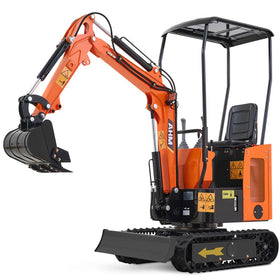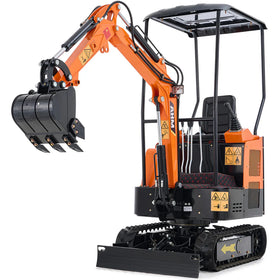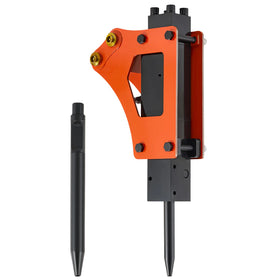Choosing the wrong size mini excavator can turn a straightforward project into an expensive nightmare. The reality is that most project delays and equipment rental disasters happen because contractors picked a mini excavator that was either too small to handle the job efficiently or too large for the space and budget.
Whether you're digging trenches for utilities, clearing stumps for landscaping, or grading a foundation, the right-sized machine makes all the difference between a smooth operation and a costly mess.

The answer to “What size mini excavator do I need”? depends entirely on your project requirements, site constraints, and the type of work you're doing. So, here's everything you need to know to make the right choice!
Why Mini Excavator Size Depends on Your Project
Different projects demand different capabilities, and one size of a mini excavator that works perfectly for one job might be completely wrong for another. The key is understanding that size affects everything from digging depth and lifting capacity to maneuverability and transportation. Here are some ways the project decides the size of your mini excavator.
1. Mini Excavator Size Affects Power and Performance
Larger mini excavators deliver more digging force, deeper reach, and higher lifting capacity. For example, a 1-ton mini excavator might struggle with compacted soil that a 3-ton machine handles easily.
2. Larger Mini Excavators Require More Space
Tight job sites demand compact machines. A 6-ton mini excavator won't fit through a residential gate, no matter how perfect it might be for the actual work that you plan to do.
Efficiency and Speed: Using an undersized machine means longer project times and higher labor costs. On the other hand, oversized equipment wastes money on unnecessary capability.
Understanding these fundamentals helps you match machine size to the project. For example, utility trenching in suburban backyards needs a compact, maneuverable machine, while foundation excavation for commercial buildings will require serious digging power and reach.
The largest size mini excavator typically maxes out around 10 tons (20,000 pounds), but the sweet spot for a majority of you will be between 1-6 tons.
Best Mini Excavator Sizes for Different Tasks
Here's a practical breakdown of which mini excavator sizes work best for specific applications:
|
Task |
Mini Excavator Size |
Notes |
|
Digging Trenches |
1-3 tons |
1-2 tons for utilities, 2-3 tons for deeper trenches |
|
Grading & Leveling |
2-4 tons |
Larger machines provide better blade control and stability |
|
Tight Spaces |
Under 2 tons |
Narrow width and compact dimensions are essential |
|
Material Transport |
2-5 tons |
Higher lifting capacity is needed for efficiency |
|
Demolition |
3-6 tons |
More power is required for breaking concrete and structures |
|
Landscaping |
1-3 tons |
Balance of maneuverability and capability |
|
Post Hole Digging |
1-2 tons |
Precision is more important than raw power |
|
Site Cleanup |
2-4 tons |
Versatility and efficiency matter most |
Removing stumps is a task that deserves special attention. To determine the best mini excavator size for stump removal, consider the diameter of the stump and the depth of the root system.
- Small stumps (under 12 inches) work fine with 1.5-3 ton machines,
- Medium stumps (12-24 inches) need 3-6-ton excavators.
- Large stumps over 24 inches typically require 6+ ton machines or specialized equipment.
Other Factors to Consider When Choosing Mini Excavator Size
1. Access and Transport
Your site's physical dimension often determines maximum machine size more than the actual work requirements. Make sure to measure gate openings, check weight limits for driveways and septic systems, and consider how you'll transport the equipment.
2. Soil Conditions
Rocky, compacted, or clay-heavy soils demand more power than loose, sandy conditions. A 2-ton excavator that handles sandy soil perfectly might struggle in hard clay.
3. Project Duration and Efficiency
Larger machines that work faster will make more sense for longer projects, while short-term jobs might favor smaller, less expensive rentals, even if they work more slowly.
4. Operator Experience
Larger machines also require more skill and experience to operate safely and efficiently. So, new operators will often perform better with smaller, more manageable equipment.
Best AHM Mini Excavators for Different Tasks
AHM's mini excavator lineup delivers the perfect balance of power, efficiency, and value across the size spectrum. Here's how our models match up with specific applications:
For Tight Spaces and Light Work: AX-12B
The AX-12B at 2,138 pounds hits the sweet spot for contractors needing maximum maneuverability without sacrificing capability.
- With 13.5 HP Briggs & Stratton power and 69-inch dig depth, it excels at utility trenching, landscaping projects, and post-hole digging.
- With its compact size, the AX-12B navigates residential gates and tight job sites that larger machines can't access, making it perfect for fence line work and small-scale excavation.
At $5,999.99, it's the most cost-effective entry point into professional mini excavator ownership.
For Versatile Performance: AX-16 Series
Step up to the AX-16 series for 23 HP performance while maintaining easy transport at 2,205-2,290 pounds.
- The standard AX-16 ($8,599.99) delivers excellent value for general excavation work and site cleanup tasks.
- The swing boom AX-16C ($9,299.99) adds incredible versatility for grading and leveling work, providing excellent control in tight spaces.
The retractable undercarriage AX-16S ($9,199.99 on sale) provides enhanced stability for heavier material transport and landscaping projects. This series handles larger drainage trenches and foundation work better than smaller models.
For Maximum Compact Power: AX-17
The AX-17 represents the largest mini-excavator that most contractors can transport without special equipment.
- At 3,651 pounds with 89-inch dig depth and 551-pound lifting capacity, it handles serious material transport and precision grading work while staying under the 4,000-pound threshold.
- This machine excels at deeper trenching projects and provides the stability needed for demanding excavation work.
The enclosed cab AX-17J adds weather protection on top for year-round operation.
For Ultimate Performance: AY-25 Series
When you need maximum power in a compact package, the AY-25 delivers 25 HP Perkins diesel performance with 992-pound lifting capacity.
At 5,401 pounds, it's still easily transportable but provides the muscle for demanding applications like large stump removal, heavy-duty demolition, and breaking concrete structures.
What Size Mini Excavator Do I Need: Making the Final Decision
Ultimately, deciding what size mini excavator you need comes down to balancing your project requirements against practical constraints.
- Most contractors will find success with machines in the 2-4 ton range because they offer the best combination of capability and versatility. S
- tart by asking yourself these key questions: What's the tightest space I need to navigate? What's the deepest I need to dig? How much material do I need to move? What's my transport and budget situation? Before settling on one.
Picking the right mini excavator size will transform challenging projects into profitable opportunities, and AHM's complete lineup ensures you'll find the perfect machine for your specific needs, backed by U.S.-based support and proven reliability.
Don't let the wrong-sized equipment slow down your projects - choose AHM mini excavators and get the job done right the first time!
Start by exploring how much fuel a mini excavator uses.







